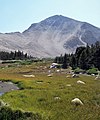Contents
Cirque Peak is a 12,900-foot-elevation (3,900-meter) mountain summit located on the crest of the Sierra Nevada mountain range in California.[4] It is situated on the common border of Tulare County with Inyo County, as well as the shared boundary of Golden Trout Wilderness and John Muir Wilderness, on land managed by Inyo National Forest. It is 14 miles (23 km) southwest of the community of Lone Pine, 7.7 miles (12.4 km) south-southeast of Mount Whitney, and 3.2 miles (5.1 km) south of Mount Langley, the nearest higher neighbor. Cirque Peak is the highest point of the Golden Trout Wilderness, and ranks as the 175th highest peak in California.[5] Topographic relief is significant as it rises 1,800 feet (550 meters) above Cirque Lake in approximately one mile. The Pacific Crest Trail traverses the southwest slope of this mountain, providing an approach option. The mountain was apparently named in 1890 by Joseph Nisbet LeConte and companions who noted the remarkable cirque on the north aspect.[6]
Climate
According to the Köppen climate classification system, Cirque Peak has an alpine climate.[7] Most weather fronts originate in the Pacific Ocean, and travel east toward the Sierra Nevada mountains. As fronts approach, they are forced upward by the peaks, causing them to drop their moisture in the form of rain or snowfall onto the range (orographic lift). Precipitation runoff from this mountain drains west to the Kern River via Golden Trout Creek, and east to Owens Valley via Cottonwood Creek.
Gallery
See also
References
- ^ a b c d "Cirque Peak, California". Peakbagger.com. Retrieved 2021-05-18.
- ^ a b "Sierra Peaks Section List" (PDF). Angeles Chapter, Sierra Club.
- ^ "Vagmarken Sierra Crest List". Angeles Chapter, Sierra Club. Retrieved 2021-11-21.
- ^ a b "Cirque Peak". Geographic Names Information System. United States Geological Survey, United States Department of the Interior. Retrieved 2021-05-18.
- ^ "Cirque Peak - 12,900' CA". ListsOfJohn.com.
- ^ Kenneth L. Taylor, Names on the Range: Scientists and Science in the Naming of Sierra Nevada Features
- ^ Peel, M. C.; Finlayson, B. L.; McMahon, T. A. (2007). "Updated world map of the Köppen−Geiger climate classification". Hydrol. Earth Syst. Sci. 11. ISSN 1027-5606.
External links
- Weather forecast: Cirque Peak
- Cirque Peak: Mountain-Forecast.com





